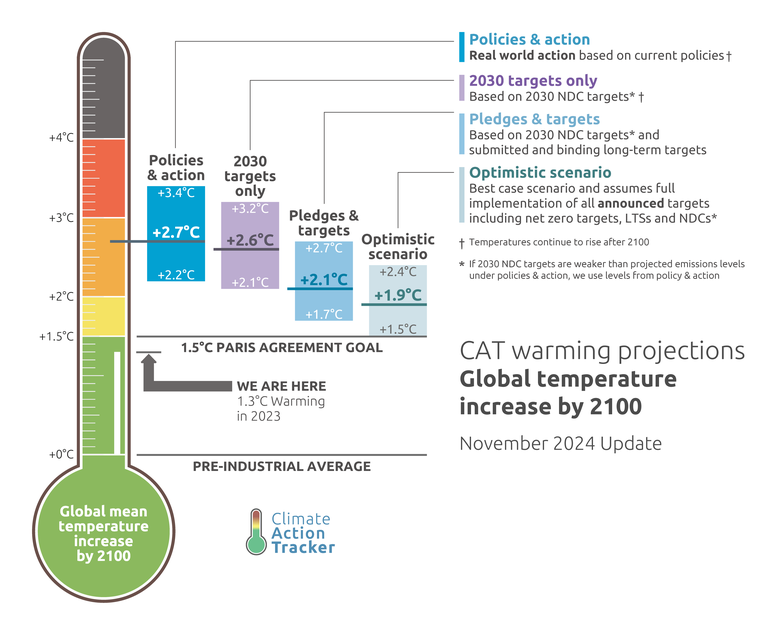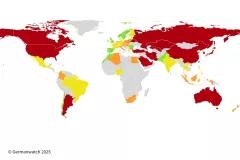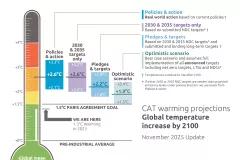- ... Trump policies make only slight increase in warming projections.
- ... sets out 2035 NDC asks for big emitters and troika.
The combined global effect of government action on climate change has flat-lined over the last three years, underscoring a critical disconnect between the reality of climate change and the lack of urgency on policies to cut emissions, the Climate Action Tracker said in its global update, released today at COP29 in Baku, along with 2035 target recommendations for big emitters and the "COP Presidencies Troika".
Warming projections global update

2024 has been a year marked by minimal overall progress, with almost no new national climate targets or net zero pledges and fossil fuel emissions continuing to increase despite governments repeatedly agreeing to urgently strengthen their 2030 targets and to align them with the 1.5° goal of the Paris Agreement.
"We are clearly failing to bend the curve. As the world edges closer to these dangerous climate thresholds, the need for immediate, stronger action to reverse this trend becomes ever more urgent," said report lead author Sofia Gonzales-Zuniga of Climate Analytics, a CAT partner organisation.
She cautioned that the current policy warming of 2.7° was a median estimate with a 50% chance of being higher or lower.
"But our knowledge of the climate system tells us that there is a 33% chance of our projection being 3.0°C - or higher - and a 10% chance of being 3.6°C or higher, an absolutely catastrophic level of warming," she added.
Stagnating warming outlook hides competing trends
While renewables and electric vehicles are reporting record-breaking progress, with investments now double those for fossil fuels, fossil fuel subsidies are at an all-time high: funding for fossil fuel projects quadrupled between 2021 and 2022. The CAT projects emissions will peak by the end of the decade but at a much higher level than three years ago.
“Rising emissions while renewables boom is not a paradox. In recent years fossil fuels won the race against renewables, leading to increasing emissions. But renewables surprise us each year with faster growth faster than expected, exponential growth that will soon see them crowd out fossil fuels. It allows much faster decline in emissions after 2030 than we thought only three years ago,” said Prof Niklas Höhne, of NewClimate Institute, CAT partner organisation.
The CAT has also undertaken an initial calculation of the projected impact of US President-Elect Donald Trump's Project 2025 planned rollback of climate policies. If limited to the US, this could increase warming by around 0.04˚C under the CAT Current Policy Pathway (2). A permanent abandonment of the US net zero target, if accompanied by more countries rolling back or delaying action would have a bigger negative impact.
"Clearly, we won't know the full impact of the US elections until President-Elect Trump takes office, but there is a clean energy momentum in the US now that will be difficult to stop. While the Trump administration will undoubtedly do its best to throw a wrecking ball into climate action, the clean energy momentum created by President Biden, being actioned across the country, is likely to continue at significant scale," said Bill Hare, CEO of Climate Analytics.
"The key issue is whether countries stick together and continue to move forward with action, a Trump rollback of US policies, as damaging as it is, can be overcome."
What would be high ambition in line with 1.5˚C for these countries?
Getting the world on track starts with the biggest emitters. The CAT also today released its recommended 2035 targets - that would be in line with modelled domestic pathways towards 1.5°C - for seven of the world's biggest emitters: (China, the US, India, EU, Indonesia, Japan, Australia) along with the Troika countries (UAE, Azerbaijan and Brazil).
"Developed countries need to continue to supplement their domestic action with significant financial and other support for developing countries to constitute an equitable contribution to the 1.5°C limit," said Ana Missirliu, NewClimate Institute, one of the authors of the briefing.
"Many developing countries can only achieve sufficient climate action with significant financial and other support. COP29 is where we need to see this financial commitment,"
Together, the seven large emitters were responsible for 60% of global greenhouse gas emissions in 2022. They need to show international leadership to drive climate action.
The Troika countries (UAE, Azerbaijan and Brazil), who have released a Roadmap to 1.5˚C, all plan to extract more fossil fuels: a massive mismatch between words and action. The ten countries together produce a total of 63% of global emissions.








